Affiliate links on Android Authority may earn us a commission. Learn more.
Samsung Galaxy M40 review: Short of perfect
July 30, 2019
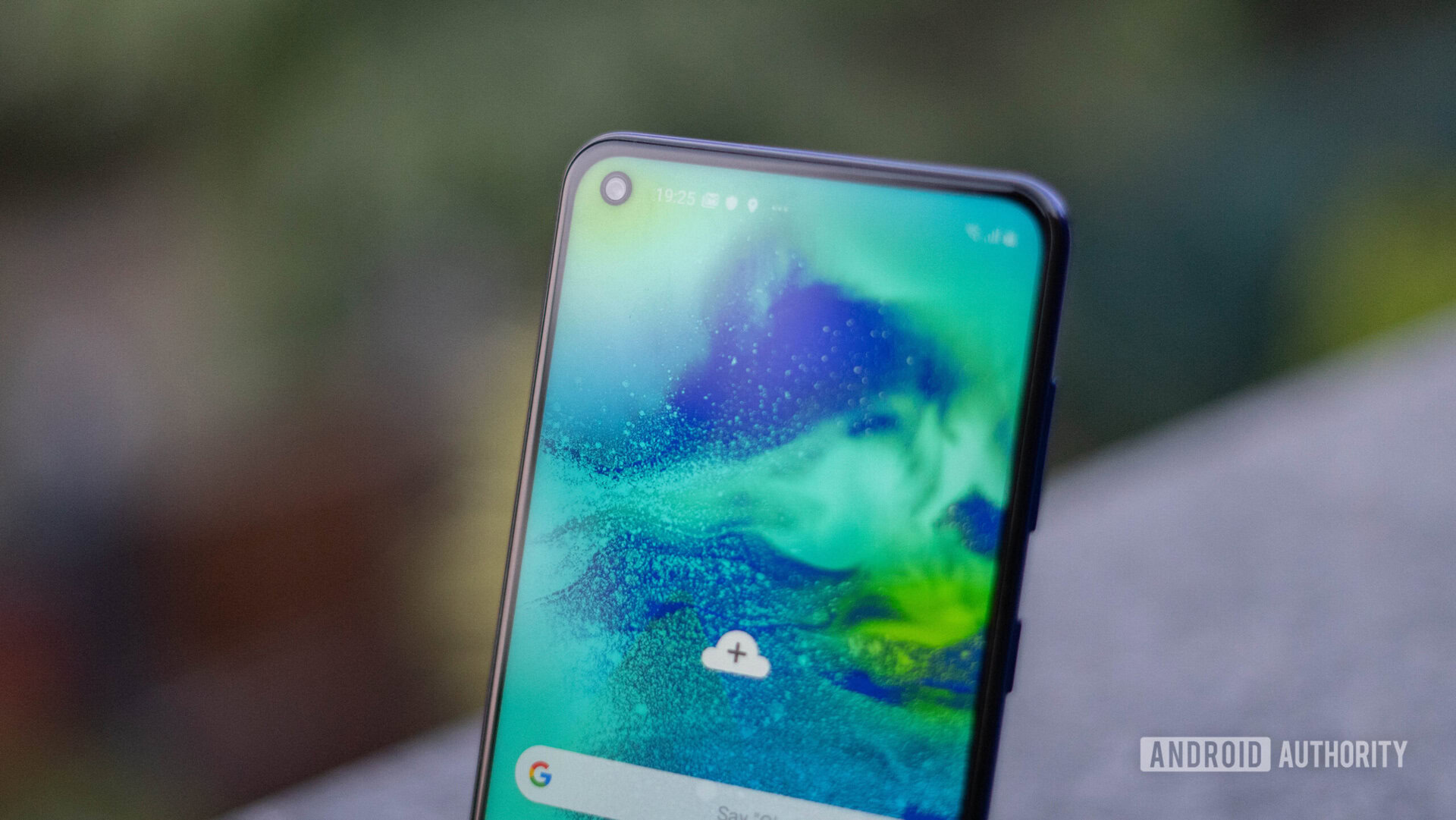
What started off as a bid to have an offering in every price segment has become a near-flood with a multitude of phones that seemingly overlap in their capabilities and price points. To say that Samsung is being overly aggressive in its mid-range strategy would be an understatement. The Samsung Galaxy M40 is yet another mid-ranger, one that puts an added focus on design.
Samsung Galaxy M40 review: The big picture
The mid-range segment — 15,000 rupees to 20,000 rupees (about $200 to $300) — is fast shaping up to be the hottest category of phones in India. Devices such as the Redmi Note 7 Pro, which focuses on the camera and performance, dominate this category. But so do phones like the Galaxy A50, one that offers a more balanced approach and widespread offline availability.
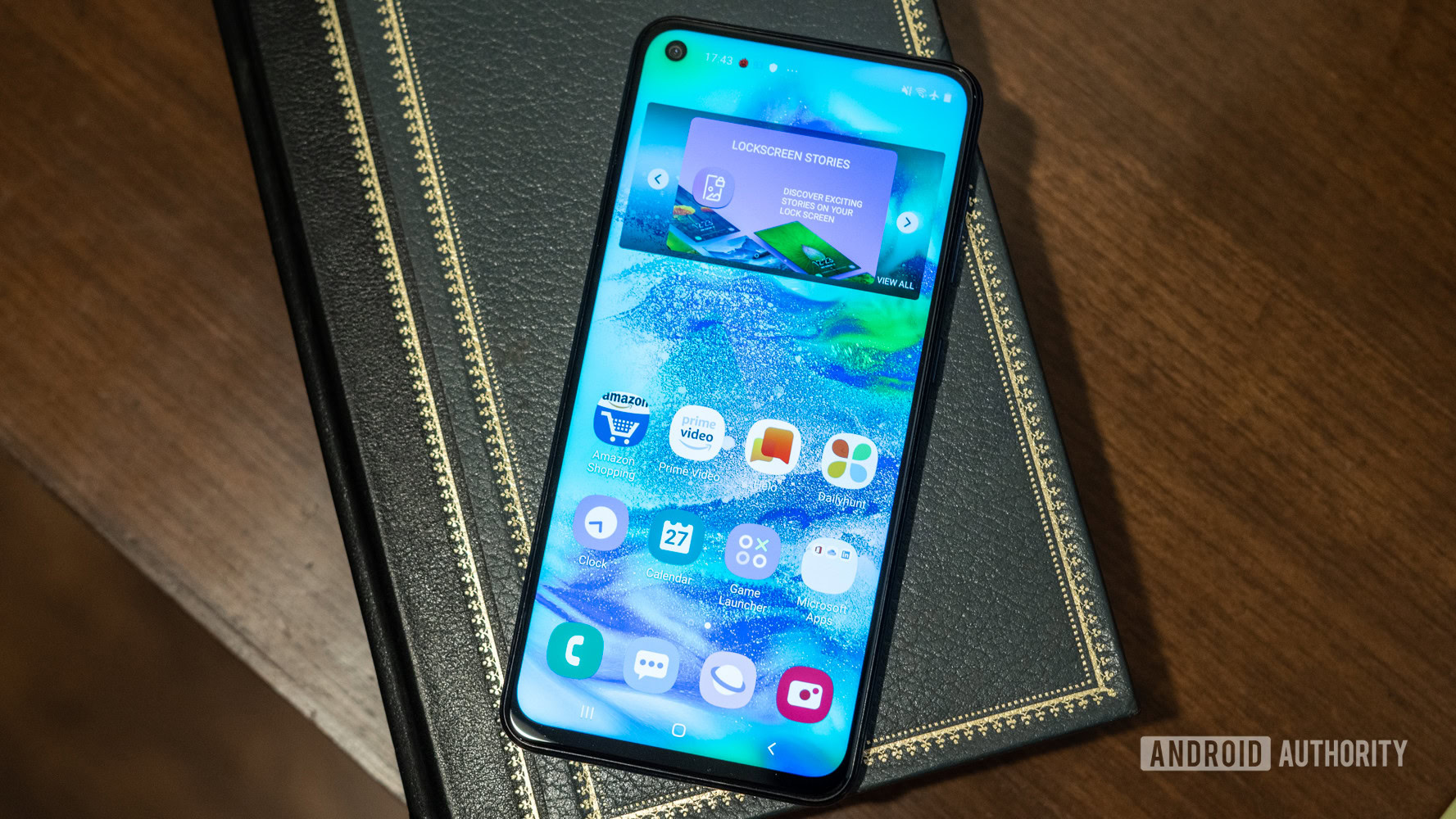
On one hand, the Samsung Galaxy M40 offers more of the same: A broader attempt to sell a good all-around package rather than one that focuses on one feature or another. The M40 brings a punch-hole design to an all-new price category and steps a notch above its contemporaries as far as design is concerned. Is that enough in a market that is saturated with a wide variety of options? That’s what we aim to find out in our Samsung Galaxy M40 review.
What’s in the box
- Galaxy M40
- 15W fast charger
- USB-C cable
- USB-C earphones
- SIM ejector tool
- Manuals
The Samsung Galaxy M40 ships in a fairly basic package. Additions are limited to a travel charger and USB-C headphones. The retail package lacks a 3.5mm to USB-C dongle, nor does it ship with a TPU case. We would highly recommend investing in the latter given that the phone is a fingerprint magnet.
Design
Amidst the growing homogeneity amongst mid-range smartphones (and especially those from Samsung), the Galaxy M40 breaks the monotony by introducing a display-hole design to this segment. The Infinity-O cutout, earlier seen on the Galaxy S10e, is just as impressive here and comes across as less jarring than a now old-school notch.
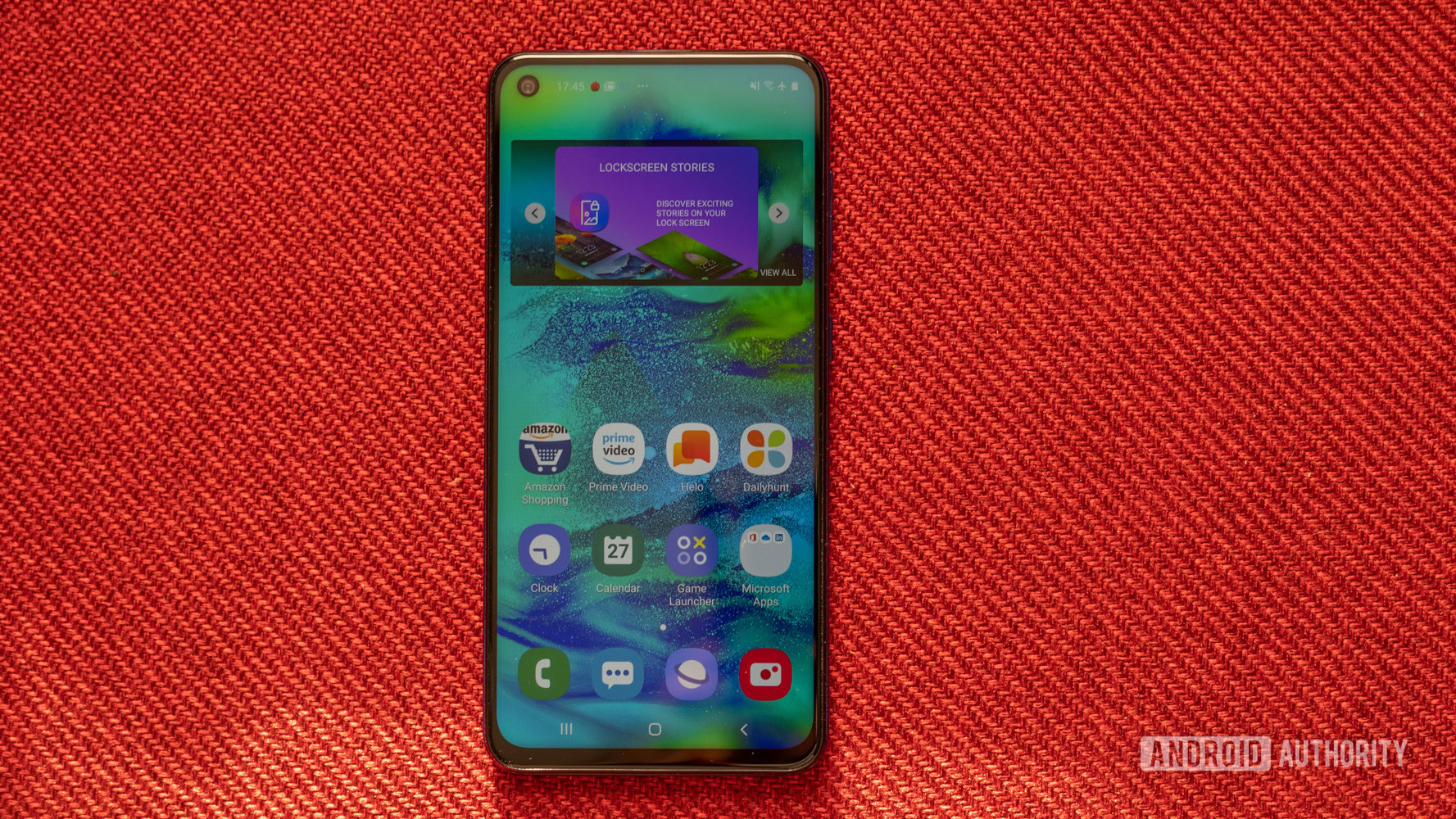
The 6.3-inch display takes over most of the front with fairly minimal bezels on three sides. The chin along the bottom edge is a bit thicker but doesn’t come across as obtrusive. You might notice the lack of an earpiece along the top edge. The Galaxy M40 makes use of “screen sound” technology to convert the display area into a speaker. While I had no trouble hearing the caller on the other end of the line, the audio output sounded just a bit hollow and tinny.
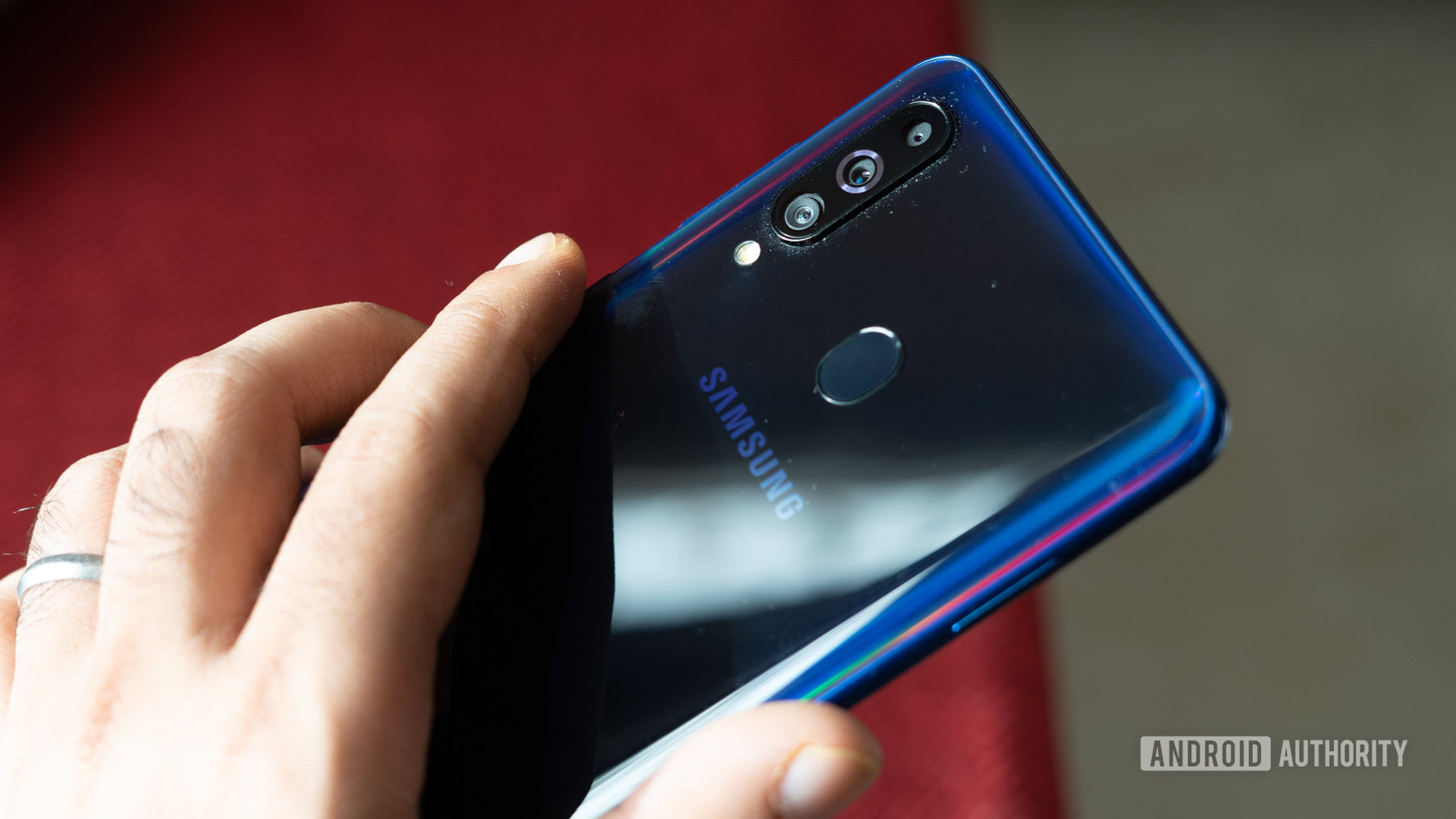
If you happen to carry your phone in your hand all the time or spend a lot of time making phone calls and browsing the internet, you’ll know just how important hand-feel can be. The overall dimensions of the Samsung Galaxy M40 are small enough to make the phone very comfortable to hold. In fact, I’d go as far as saying that this is perhaps the most comfortable device to use amongst the recent crop of Samsung smartphones. The sub-170g weight definitely helps here.
The polycarbonate body started showing signs of scratches and scuffs within days of use.
Not everything is positive though. For one, the phone lacks a headphone jack. The phone ships with USB-C earphones in the box, but that doesn’t quite make up for the missing port. Next, the polycarbonate material used for construction is a fingerprint and scuff magnet. In our week or so of use, the phone began to show minor scratches. I suspect that it won’t fare too well with long-term use, making a quality case a mandatory purchase.
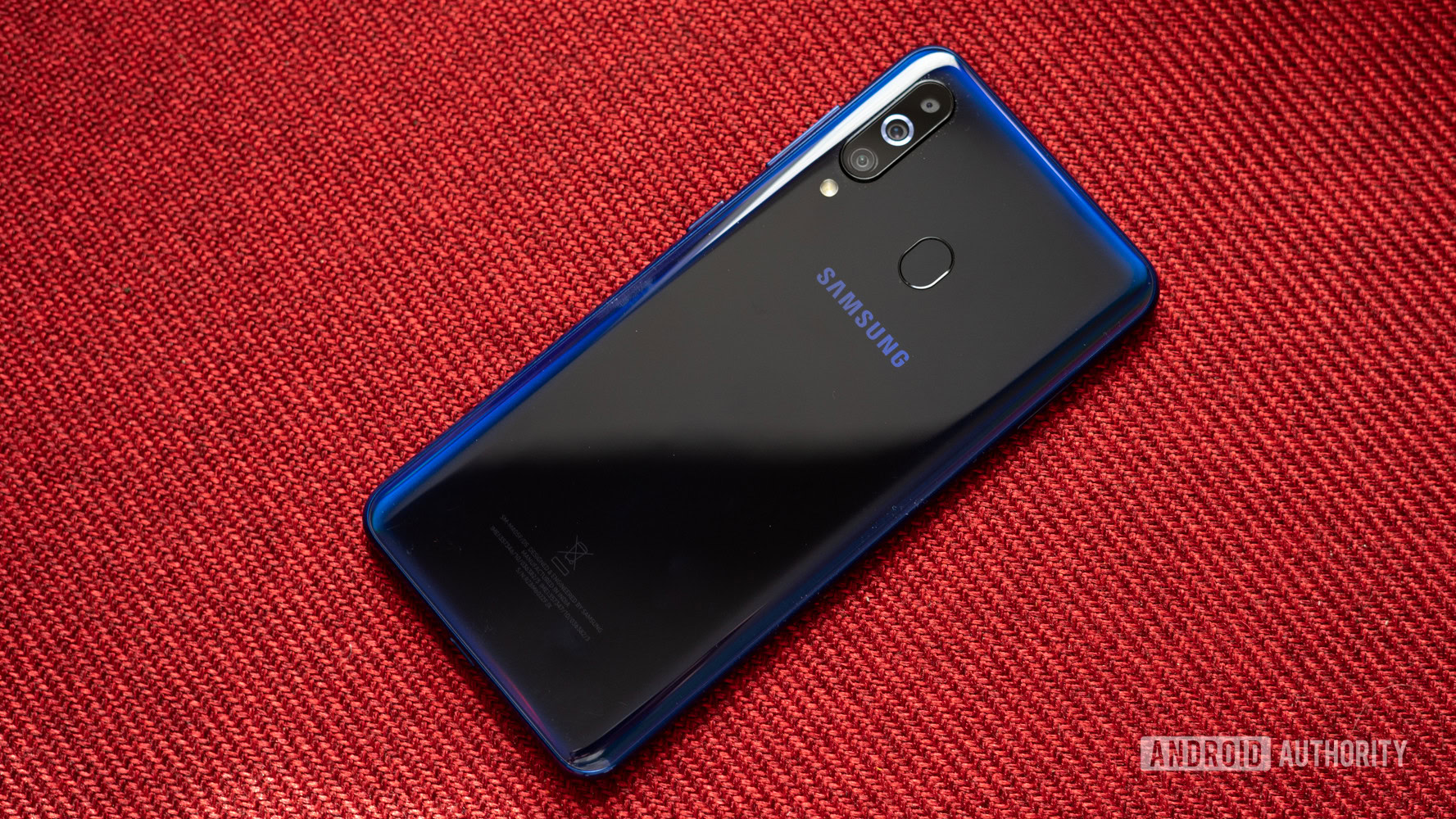
Unlike the Samsung Galaxy A50, the M40 does not sport an in-display fingerprint reader. Instead, you get a rear-mounted fingerprint scanner. It is fast, it works just fine, and I doubt many will complain about it. Should you prefer it, there is support for face-unlock as well, though it was noticeably slower than using the fingerprint scanner.
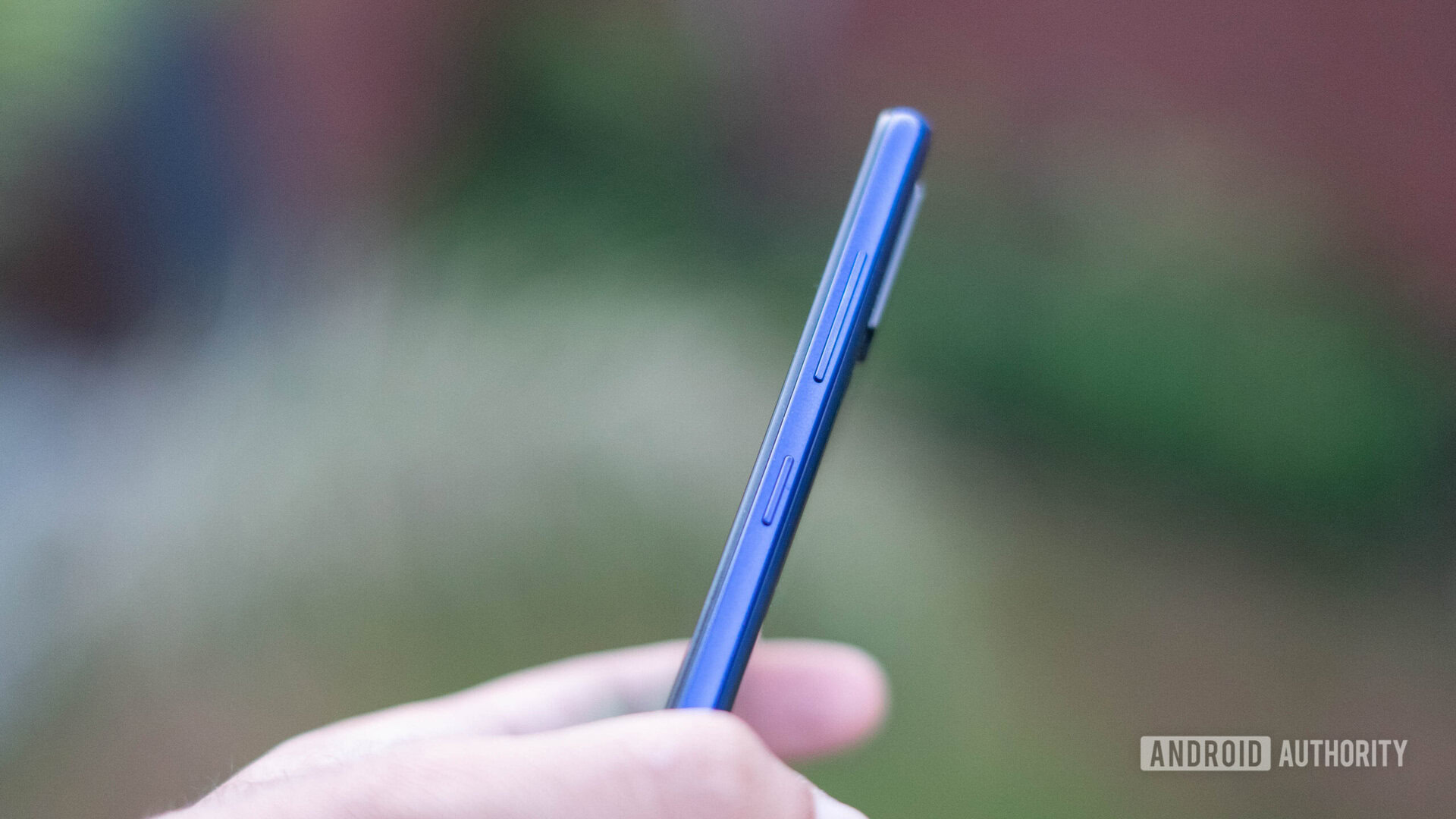
The entire build of the phone is polycarbonate and it feels reasonably good. The buttons offer sufficient feedback, though they don’t feel quite as tactile as those on Xiaomi’s Redmi series. No, the phone does not have any official IP rating, nor is there any mention of a P2i coating, so you will want to be extra cautious when using your phone around water.
The phone uses a gradient-style pattern in the polycarbonate. Instead of the more common top to bottom fade, the color shift pattern is all around the edges. All in all, while the Galaxy M40 wins out in the design department, it is clear that some compromises had to be made to get here.
Display
- 6.3-inch LCD
- 2,340 x 1,080, 409ppi
- PLS TFT LCD panel
- Infinity-O punch-hole
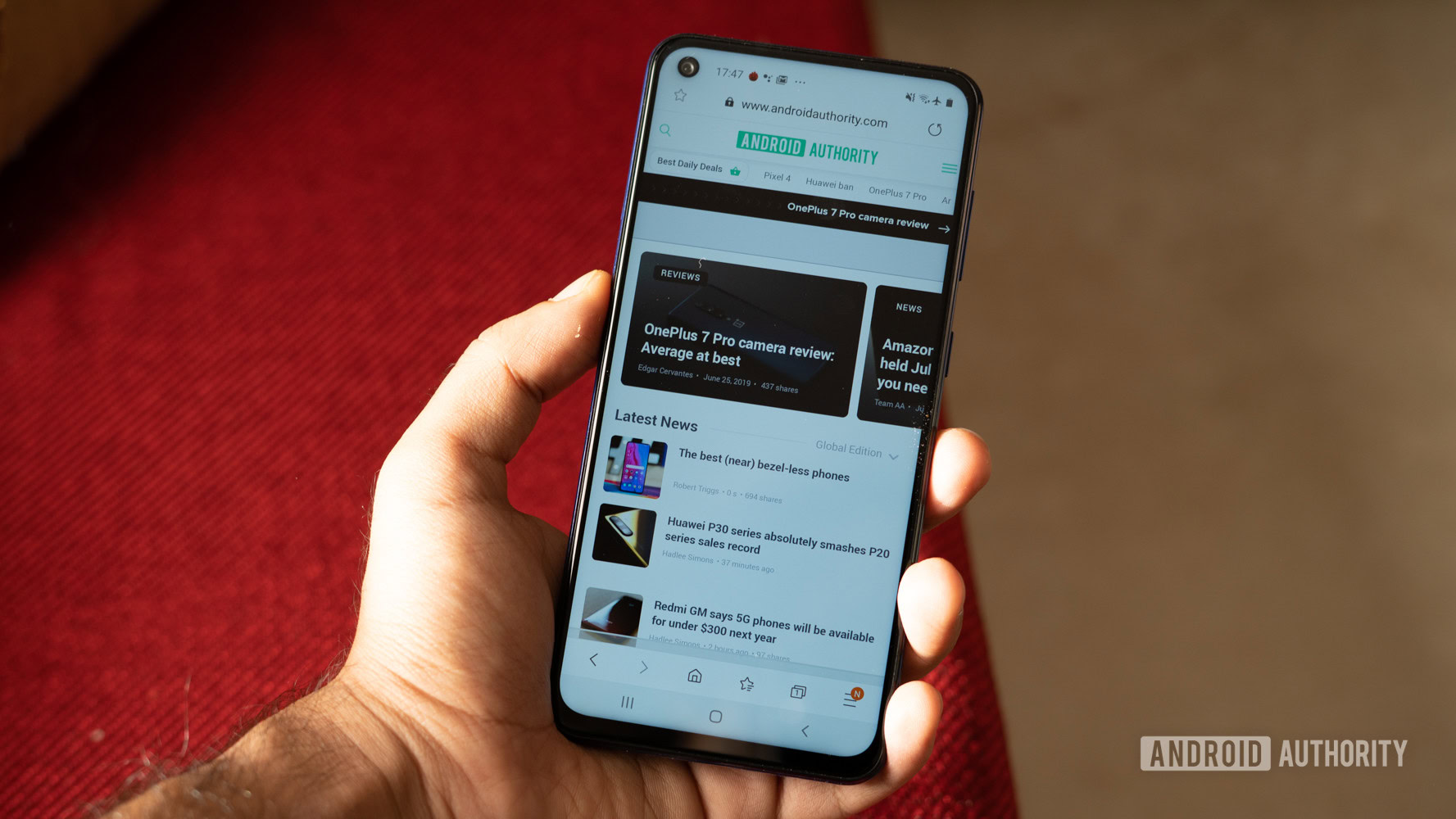
Unfortunately, Samsung does not provide any way to switch to a more natural color tuning like on competing devices. The LCD panel also does not drop as dimly as Samsung’s own AMOLED-toting Galaxy M30. The black levels, too, do not come close to the latter, which is a bit of a shame given the premium pricing of the smartphone.
Yes, the phone supports the Widevine L1 DRM, enabling you to view Full HD content from streaming services.
Performance
- Snapdragon 675
- Adreno 612
- 6GB RAM
- 128GB storage
The Galaxy M40 lacks that finesse that we've seen on recent Samsung mid-rangers.
Beyond that, the phone held its own as far as multitasking and gaming is concerned. I played PUBG on the phone and the Galaxy M40 maintained a solid frame rate with the graphics set to HD. The phone got warm to the touch, but never uncomfortably so. We also ran a whole range of benchmarks to ascertain relative performance and you can take a look at the scores below.
Battery
- 3,500mAh
- 15W Fast Charging
The Galaxy M40’s 3,500mAh battery is smaller than almost every other device in this price band, putting the phone at an immediate disadvantage. Now, Samsung claims it has worked on optimizing the phone for all-day use — but that’s its limit. While competing devices will manage to chug along into the next day or even further, the Galaxy M40 runs out of steam by the end of the day.
Average screen-on time hovered around the five hour mark during my time with the phone, which is noticeably worse compared to the competition. Charging the phone is reasonably fast and you can top it off in about 96 minutes using the included 15W fast charger.
Software
The Samsung Galaxy M40 runs Android 9.0 Pie with Samsung’s One UI 1.1 layer on top. Over the years, Samsung has made significant strides in reducing visual clutter and bloat to make this a truly enjoyable take.
From the gestures to the usual additions smattered across the interface, One UI on the Galaxy M40 is very intuitive for a first-time smartphone buyer whilst offering enough bells and whistles for long-time users.
The default launcher lets you make tweaks like switching between an app drawer-enabled layout or one in which all the apps are on the home screen itself. The software offers an easy way to switch between grid sizes in case you wish to increase information density. It is nice to see that Samsung has integrated some of the functionality from custom launchers into the default launcher.
The phone isn’t entirely bereft of bloatware and includes a few additions such as Samsung’s own Galaxy Apps app-store, as well as third-party apps like Helo and Dailyhunt. It is possible to uninstall some of these.
Camera
- Rear:
- 32MP standard at f/1.7
- 8MP ultra-wide at f/2.2
- 5MP depth sensor
- Front:
- 16MP
Multiple cameras are the flavour of the season and the Samsung Galaxy M40 sports four of them. The three sensors on the back of the phone offer a high-resolution primary camera paired with ultra-wide and depth sensors. No, you won’t find a telephoto lens here.


Autofocus performance is definitely slower than you would expect. I also observed a bit of shutter lag, which can result in blurry images if you don’t stay perfectly still while taking the picture. This issue is exacerbated in low-light situations where it is particularly hard to capture perfectly sharp images. By default, the primary camera outputs 12MP images from its 32MP sensor, this helps in reducing noise and improving low-light sensitivity.
A definite issue with the Galaxy M40’s camera is its tendency to over-expose the setting. Images turn out brighter than they actually are and have a hint of over sharpening around the edges. The wide-angle shots, in particular, end up brightening the shadow areas. This makes for a striking shot, but pixel-peeping reveals an increased amount of noise.
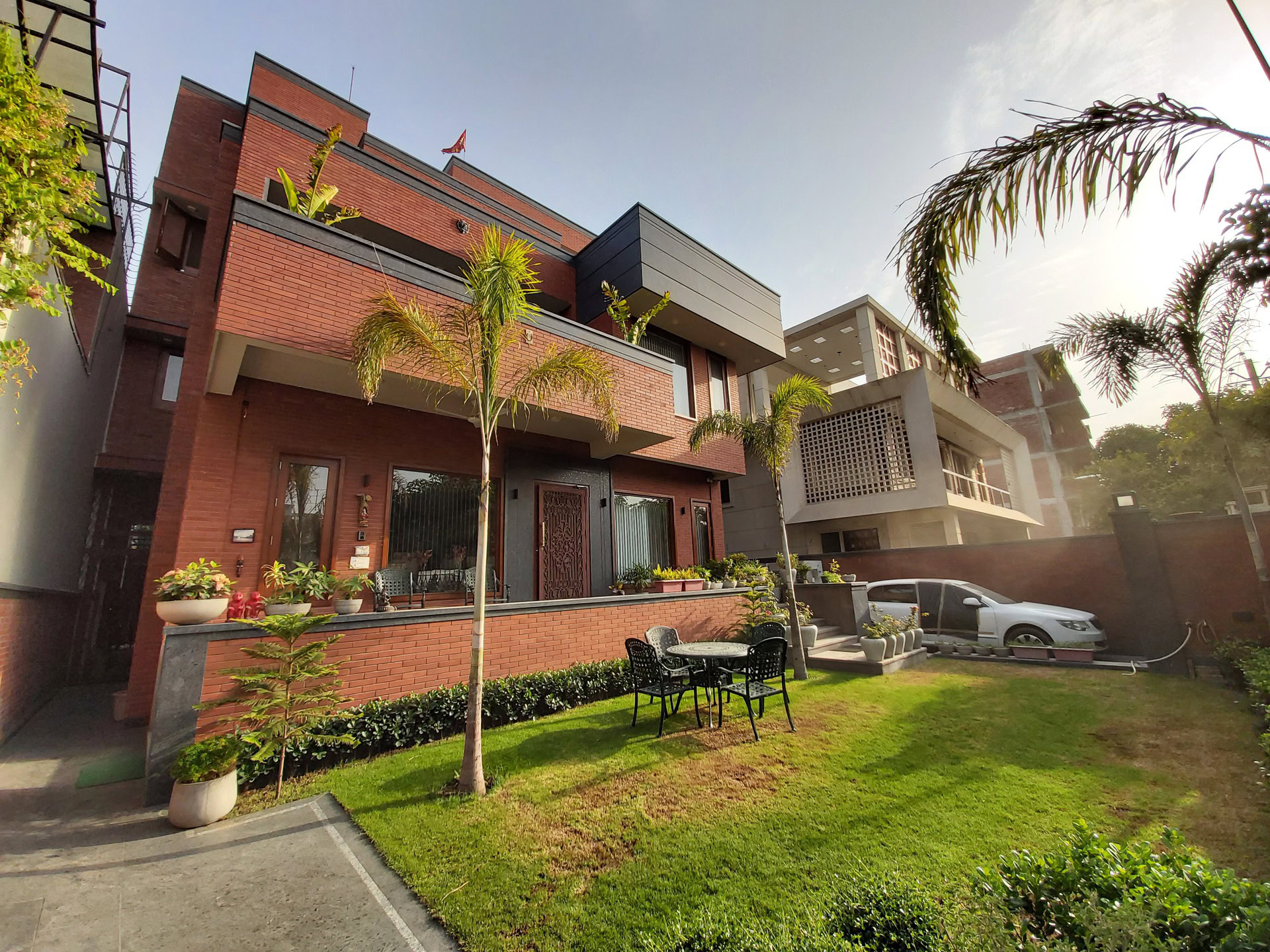
The wide-angle camera lacks auto-focus capabilities and is best used for capturing landscapes or architecture. The camera doesn’t handle shooting into the sun well and it can, on occasion, lead to significant lens flares. You can take a look at full resolution Galaxy M40 camera samples by following through to the link.
I wasn’t very impressed by the portrait mode on the M40. While the phone did a reasonable job at identifying the profile of the person, bokeh drop-off was very artificial looking.
Video capabilities on the M40 top-off at 4K at 30fps but the phone lacks any form of stabilization, which makes capturing stable footage an exercise in frustration.
Audio
As we mentioned earlier, the Samsung Galaxy M40 lacks a headphone jack. You do get a pair of USB-C headphones in the box, but a dongle is not provided.
Audio output from the speaker is loud, but nothing worth writing home about. The mono speaker sounds shrill and lacks depth. Owing to the bottom-firing position of the speaker, it is likely that you will cover it up while playing a game or while watching a video.
Specifications
| Samsung Galaxy M40 | |
|---|---|
Display | 6.3-inch IPS LCD 2,340 x 1,080 Full HD+ 409ppi |
Processor | 2GHz octa-core Qualcomm Snapdragon 675 Adreno 612 GPU |
RAM | 6GB |
Storage | 128GB expandable |
Camera | Rear: 32MP standard f/1.7 8MP wide-angle f.2/2 5MP depth Front: 16MP standard |
Battery | 3,500mAh |
Software | Android 9.0 Pie |
Dimensions | 155.3 x 73.9 x 7.9mm 168g |
Value for the money
- Samsung Galaxy M40: 6GB RAM, 128GB ROM — 19,990 rupees (~$280)
On the face of it, the Samsung Galaxy M40 is a fairly decent package. It is, however, marred by a less than perfect implementation. Be it the just short of fantastic performance or the less than stellar battery life. Moreover, the cameras are not quite as good as the competition.
Ironically, Samsung’s own Galaxy A50 comes across as a solid competitor to the M40. The A50 has a slightly larger display, significantly better battery life, and cameras that are just a smidgen more consistent. It also helps that the A50 offers a fantastic user experience right out of the box.
On the other hand, there’s the Redmi Note 7 Pro. Xiaomi’s mid-ranger set the benchmark for what a value-priced package should offer to excel. Between the specs, the class-leading camera, and top-notch battery-life, the Note 7 Pro is hard to ignore as an alternative.

Samsung Galaxy M40 in the news
Report: Samsung extends shipment lead in Q2 2019, as realme enters top ten
Samsung Galaxy M40 review: The verdict
The Samsung Galaxy M40 is a good phone that falls just short of excellence. It isn’t quite the perfect package, but it might be the phone for you if design excellence ranks higher than overall performance in your books.
What do you think about the Galaxy M40? Is this the phone to take away the crown from Xiaomi’s Redmi Note 7 Pro or is the smaller battery and weak camera enough of a deterrent?